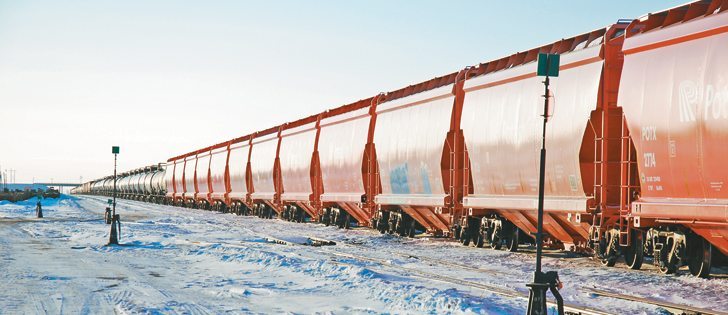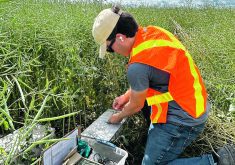This year’s grain transportation problems might be an exceptional situation arising from a record crop and a long period of frigid weather, but it is a wake-up call for the need for new thinking in the grain handling and transportation sector. Expanding crop production will vie with other growing sectors of the economy for rail service. To avoid limitations caused by growth, shippers, railways and government must find ways to move greater volumes reliably. In this final part of his special report series, Brian Cross sums up the problems and sets out 14 issues that if addressed, could unlock Canada’s grain export potential. (part three is available here). Moe and Kinew have a fight on their hands when it comes to eliminating the EV tariff. Canada has to worry about pissing off the U.S. and Mexico and hundreds of thousands of auto workers.
Read Also

Why feds imposed EV tariffs
No matter what farmers think about the current state of rail service, there is one fact that should never be in doubt: shipping western Canadian grain to market, especially in the dead of a western Canadian winter, is a massive challenge.
And if you believe Mark Hemmes, president of Quorum Corp., the challenge will only become more onerous as prairie farmers continue to grow larger crops.
Hemmes says Western Canada has traditionally exported 27 to 31 million tonnes of grain and oilseeds a year.
Almost every kernel of that is loaded, unloaded, reloaded, unloaded a second time, then reloaded a third or fourth time and then hauled thousands of kilometres to markets around the world.
The grain travels by road, rail and water over hammered-out country roads, crumbling highways, mountain ranges and a railway system that has seen varying degrees of investment since it was built more than a century ago.
And by all accounts, export volumes will continue to rise.
As global demand for grain increases, and as western Canadian farmers become more adept at producing crops, more tonnes will be squeezed through a system that is already stressed and inadequate.
Hemmes said average production of cereals, oilseeds, pulses and specialty crops in Western Canada was estimated at 40 to 45 million tonnes a year in the 1980s.
Today, average production is more than 50 million tonnes a year, and growing. The 2013 harvest, easily the largest on record in Western Canada, surpassed 75 million tonnes.
“This is the new normal,” Hemmes told frustrated grain farmers at a recent grain transportation symposium in Assiniboia, Sask.
Hemmes said grain movement patterns are also changing, including record volumes shipped through export terminals in Vancouver.
The elimination of single desk grain marketing is not the only factor behind that growth, but it is a factor worth recognizing. It has prompted private sector companies to pursue new markets and look for ways to get grain to global markets more economically.
Not all of those efforts have worked according to plan.
Last year, the amount of Canadian durum flowing through west coast export facilities increased dramatically.
For years, durum shipments have moved primarily eastward, to Thunder Bay.
Tim Heney, chief executive officer of the Thunder Bay Port Authority, said much of Vancouver’s new durum business was prompted by low ocean freight rates.
Grain companies were convinced it was more economical to move durum west, through Vancouver, then east through the Panama Canal to destinations in Europe and the Middle East.
As illustrated by the number of ships waiting in Vancouver, grain companies will likely think twice before using a similar strategy this year.
West coast shipments of canola are also up, largely because the Canadian canola industry is now producing larger crops with higher yields.
Western Canadian canola yields routinely exceeded 50 bushels per acre last year.
Based on those numbers, the canola industry was able to achieve two years earlier than expected its goal of producing 15 million tonnes of canola by 2015.
The industry has now set its sights on an ambitious new production target: 26 million tonnes of production by 2025.
How much of that production can the industry reasonably expect to squeeze through existing export channels?
“We’ve seen a big change in the movement or the flows of grain across Canada,” Hemmes said.
“In the past eight or nine years of the Grain Monitoring Program, west coast movements have been between 14 and 16 million tonnes per year. But in the last four of five years, that number has jumped. It’s now up around 21 and a half million tonnes … and that’s a huge shift. Is that the new normal? We think it is.”
Meanwhile, business at Canada’s major railway companies has never been better.
Canadian National Railway and Canadian Pacific Railway are running full out to serve Western Canada’s buoyant economy.
Oil traffic is up, container shipments are up and potash traffic will only increase as new projects come online and existing ones expand production.
Both railways reported record income last year, together generating about 3.56 billion in profit on revenue of $16.7 billion. And there are no indications that rail traffic is likely to decrease soon.
The railways now suggest little or no western Canadian grain will move through southern and eastern railway corridors, at least in the short term.
Grain markets in the United States are often too small to support unit trains, and car cycle times to the U.S. are too long, say industry experts.
Besides, there are too many other products to move to the U.S. and Eastern Canada and not enough railway capacity to move grain as well.
“We want to move grain. We want to move all commodities,” said CP president Hunter Harrison during a recent speech in Calgary.
“(But) I don’t think Canada wants us to say, ‘just move the grain (and) forget about the coal and the potash and all the other stuff.’ ”
Officials from CP and CN have stated repeatedly that agricultural shippers need to take a realistic look at the situation and alter their expectations.
“Nobody was anticipating a crop of this size and I think that’s a reality that people really need to keep in mind,” said Mark Hallman, director of communications at CN.
“You can’t just move it all at once. You just simply can’t physically move the entire crop in a three-month period.”
Railway officials note that rail car unloads at Vancouver this year are higher than the five year average.
However, grain companies say that doesn’t excuse the railways for providing a level of service that is well below what was promised.
According to service plans that were shared with grain companies last fall, the railways said 10,000 to 11,000 hopper cars would be spotted in the country each week.
Recent estimates provided by the Western Grain Elevators Association show that the difference between the number of rail cars promised and the number actually delivered so far this year was 51,000 as of mid-February.
That represents a shortfall of 4.6 million tonnes of grain that grain companies had promised to overseas buyers but had not been delivered on time.
What remains to be answered is whether it was reasonable for railways to imply that 10,000 to 11,000 grain cars per week could be delivered and whether grain companies should have scrutinized those figures more closely and compared them with past railway performance.
Perhaps cold weather affected everyone’s ability to make accurate projections.
Gerry Gault, a grain worker at Vancouver’s Cascadia Terminal and president of Grain Workers Union, Local 333, said poor railway performance isn’t the only factor affecting grain movement this winter. Co-ordination is also a major issue.
Gault said Panamax vessels, which carry 50,000 to 60,000 tonnes of grain at a time, are waiting longer than ever to be loaded since single desk marketing was eliminated in 2012.
At one point last month, more than 50 ships were waiting on the West Coast, accruing demurrage charges at an estimated rate of more than $600,000 per day.
Gault said ships that used to collect partial loads of CWB grain at three or four export terminals in Vancouver are now collecting partial loads at one terminal, then sitting at anchor waiting for more tonnage from the same facility.
In extreme cases, some ships have waited more than two months to be fully loaded.
Is that a problem with railway service? Gault doesn’t think so, at least not entirely.
“We believe that the biggest issue that the industry faces right now is logistical co-ordination,” said Gault, who has worked at Cascadia for 32 years.
“Under the wheat board, if the board knew what vessels were coming in, they tried to get that product leaving the country and heading toward Vancouver. Now it doesn’t seem to have that same kind of cohesion.”
At the same time, grain trains arriving in Vancouver often contain a larger mix of products, including canola, spring wheat, durum and soft white wheat. The arrival of those products is frequently out of sync with the ships that are waiting at port.
“What I believe is needed for the industry as a whole is a co-ordination desk, where all the grain companies are putting through all of their information,” Gault said.
“If there’s a vessel that’s waiting for seven or 8,000 tonnes to finish, they don’t have to get kicked out to harbour and wait a week or 10 days to finish. Instead, they can just move across the harbour, pick it up (from another terminal) and somebody in Winnipeg or Regina can figure out what the cost of that is.”
He said rail deliveries to Vancouver have not been great this year, but disruptions in rail service to the West Coast are nothing new, especially in January and February.
“Railway deliveries have been spotty at best, but we’ve always had that problem of the cargo not being here. That’s why the system of being able to jump from terminal to terminal worked best.”
Gault said storage capacity is not a major concern on the West Coast.
“We’ve definitely got the capacity here to handle everything. It’s just got to arrive at the right time,” he said.
“It’ll take an awful lot of new farmland for farmers to be able to outgrow our existing capacity.”
The WGEA agreed, saying last month that there was “significant untapped port terminal unload capacity in Vancouver, Prince Rupert and Thunder Bay.”
Meanwhile, demands for a solution to this year’s marketing and logistical challenges are gaining momentum in Western Canada’s grain growing heartland.
Last week, western premiers and agriculture ministers waded deeper into the murky world of railway regulation, demanding that Ottawa take immediate steps to ensure railway companies provide more timely and predictable rail service to agricultural shippers or be subject to financial penalties.
Among other things, Ottawa has approved significant changes to the Grain Monitoring Program (GMP), which will provide more data on grain movement to the U.S. and through previously unmonitored corridors.
GMP changes will also shed more light on car cycle times, the number of grain cars on order and the number of orders outstanding.
All told, the changes will help shippers and politicians paint a more complete picture of railway performance and the need for additional regulations or legislative amendments.
Ottawa has also renewed the mandate of the Crop Logistics Working Group and is providing financial support for a five-year $3.2 million industry-led study that will look for ways to measure and improve the system’s ability to get products to market reliably and on time.
The language used by federal and provincial politicians regarding railway service has become more emphatic.
“We’re definitively saying the federal government should look at all of its legislative options,” Saskatchewan premier Brad Wall said last week.
“We’re way past the point when we’re losing international customers, when a sector of Canada’s economy is under the pressure it is, we are now past the point of trying to accommodate everyone’s interests on a volunteer basis. We need action.”
Alberta agriculture minister Verlyn Olson said the railways need motivation from the federal government to ensure they are maximizing their capacity to haul grain.
“Waiting for some sort of collaborative, voluntary solution may not be leading us to the kind of quick action that we need,” he said.
“We think the federal government needs to give the parties a push.”
CP’s Harrison said finger pointing will do nothing to improve the situation.
“Our people are out there scratching and fighting every night to move every bit of every commodity that wants to be moved,” he said.
“I think some of my frustration … is that we’re becoming so divisive that everything is finger pointing. If we could just stop and quit criticizing … and sit down at the table and see if we could work this out in civil ways.”
















